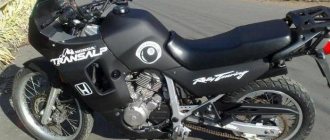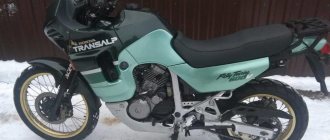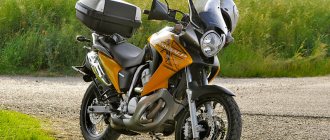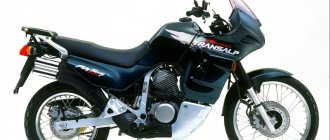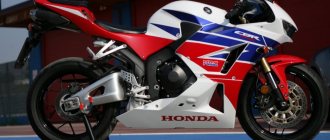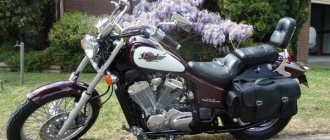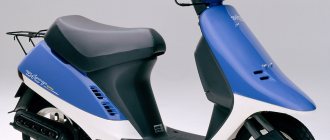- motorcycle model, BMW brand
The chassis, engine, and electronics of the BMW F650 ST (ST = Strada) are deliberately made as simple as possible, but the presence of two carburetors and two spark plugs on one side complicates but also increases the reliability of the motorcycle design.
The motorcycle is quite economical, consumption does not exceed 4.7 liters per hundred. It is equipped with a plastic tank, a powerful generator, and a quiet, non-irritating exhaust sound. The dynamics of the BMW F650 ST are very decent, it easily takes off from the gas, which does not entail oil starvation thanks to a dry sump. Suspensions can forgive a fall into an asphalt hole, and off-road features. A low seat will allow you to lean on or row your legs if the two points of contact with the earth's surface offered by the motorcycle wheels are not enough.
The single-cylinder engine of the BMW F650 ST is characterized by rather noisy operation, which is smoothed out thanks to the use of high-viscosity oil. Automotive semi-synthetic Total 15w-50 is ideal.
Among the disadvantages of the BMW F650 ST, we can note the difficulty of accessing the carburetors for cleaning, the possibility of creating a plug in the thin fuel pipe coming from the tank, the short service life of the bearings (15-20 thousand km), which at the first opportunity it is advisable to replace with high-quality analogues.
Overall, the BMW F650 ST is an excellent car and can be quite successfully used both for long off-road trips and to perform purely utilitarian functions in the city or in the country.
Honda XL 650/700 V Transalp (2000–2015, RUB 170,000–400,000)
Let's not take into account the XL 600 V Transalp announced back in 1986. We’ll probably leave the 400 cc version alone too. These are all fossil mammoths. The roots of the Transalp family go back to the most ambitious rally raids and the champion “axe” Honda NXR 750 V. In fact, Transalp is another honest device outside of marketing and, by and large, outside of time.
Modifications
The founder of the genre, the Honda XL 600 V Transalp, was announced at the Paris Motor Show in 1986. Following it, the Honda XL 400 V Transalp was released for the Japanese domestic market in 1991. In 2000, the Honda XL 650 V Transalp saw the light of day; in 2005, the model underwent minor cosmetic changes. The final generation of the Honda XL 700 V Transalp appeared in 2008. In 2009, Honda introduced the anniversary version of the XL700, featuring a touring body kit and colors. In 2013, Transalp was discontinued.
Engine
The power unit in this case is a relic. The organ donor was an unknown classic Honda VT500 Ascot motorcycle. In early versions of the Alps, the V-shape was equipped with six valves and four spark plugs for two cylinders, a carburetor power system and a liquid cooling system. Further more. The first “650” in 2000 already sported a displacement increased to 647 cm3. But otherwise the design of the motor was unchanged. A global upgrade of the power unit took place along with the change of generations in 2008. Engineers squeezed into the Honda XL 700 V Transalp a 2006 engine developed for the Honda Deauville. The main innovations are a displacement increased to 680 cm3, an electronic fuel injection system, a return to two spark plugs for everything, and four-valve heads instead of three-valve ones.
The Transalpa engine, regardless of its version, is extremely reliable. There is practically no oil waste; runs without major repairs of up to 200,000–250,000 km are not uncommon. Of the minor troubles, we can only note occasional problems with coolant leakage from the radiator of the cooling system and a general inability to cope with brisk and dynamic driving in traffic and on the highway.
Transmission
The Transalp has never been a particularly fast motorcycle. Perhaps this is why the designers, despite the pleas of the owners, never bothered to install a sixth stage in the gearbox. Early versions had problems with clutch friction discs and problems with splines on the gearbox output shaft.
Frame and body kit
Taking a closer look at the Honda XL 700 V Transalp, an interesting move by Japanese designers catches the eye. On the side plastic, under the nameplate with the model name, GPS coordinates 44.192453, 6.482233 are displayed as a kind of enticement and guide to action. They point to the high mountain road Col de la Bonne in the French Alps.
The design of the frame throughout the development of the model has undergone some major and not so significant changes, but has always remained monumentally unshakable. Over the years, plastic, unfortunately, became smaller and thinner, but did not reach criminal values. “Transalp” is one of those motorcycles that, while making its way through what is called a road on the map, can lie down to rest a couple of times, but without losing its presentation and the ability to continue moving.
Brakes
Regarding the braking system, in the case of the Transalps, the manufacturer took the path of least resistance. The mechanisms were chosen for reasons of minimal sufficiency, which slightly limits the dynamic capabilities of the motorcycle. The 650 was equipped with two 256 mm diameter discs and primitive two-piston calipers at the front, as well as one 240 mm disc and single-piston caliper at the rear. The 700 received a combined braking system with three-piston calipers and 256 discs at the front from the more advanced representatives of the model line. And even with ABS. The main enemies of the Honda XL 650/700 V Transalp brake system are time and sand.
Pendants
The suspensions of the two most modern generations of Honda Transalp are not the richest inheritance from the earliest representatives of the family. The telescopic non-inverted fork in the case of the XL 650 Transalp has a slightly larger stroke (200 mm versus 117 mm for the “700”), as well as protective rubber corrugations. The fork of the XL 700 V Transalp has limited travel and no protection. During the transition between the two final generations, the rear shock absorber lost 1 mm of travel (from 172 mm to 173 mm), but in addition to the preload adjustment, it acquired a compression adjustment. The front fork is not adjustable. The primitive pendulum made of steel profile has not seen evolutionary development since the release of the very first “Transalp”. In the case of the 700, the engineers returned to tires with dimensions almost similar to those of the XL 600, namely 100/90-19 and 130/80-17. Wheels are spoked.
Comfort
In terms of comfort, Transalp is one of the founders of the genre of inexorable tourism everywhere and always. The motorcycle is comfortable in everything that does not concern high speeds. At cruising speeds of 100–140 km/h, the Alpa driver can drive for as long as he likes, covering several thousand kilometers per day. The presence of a passenger unpleasantly conceals ground clearance and dynamics, but does not in any way affect the regularity of movement.

